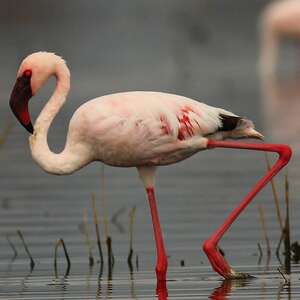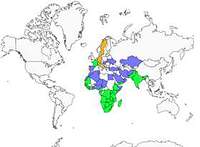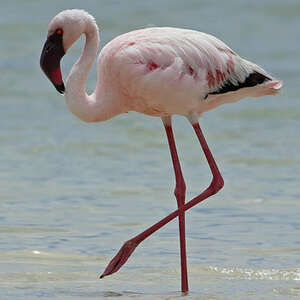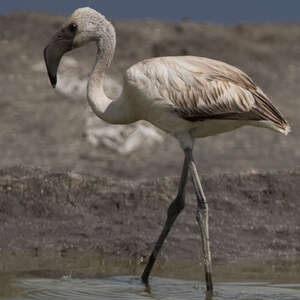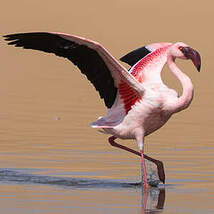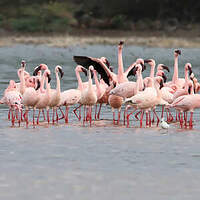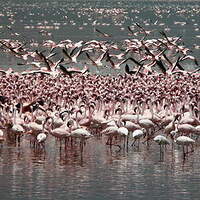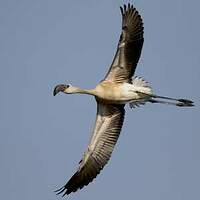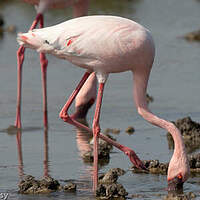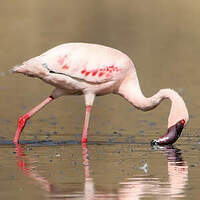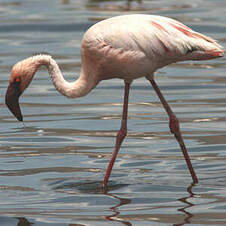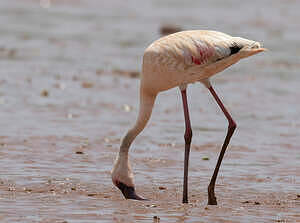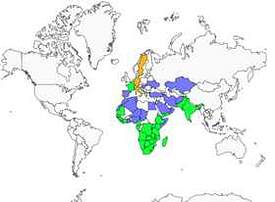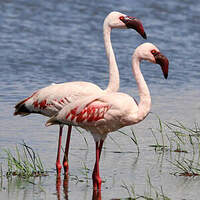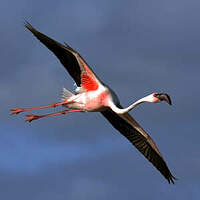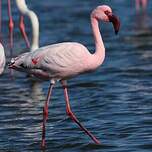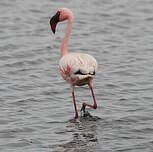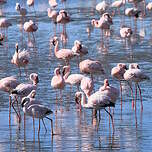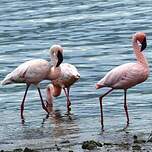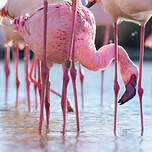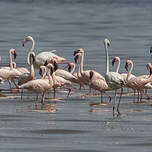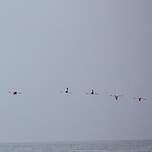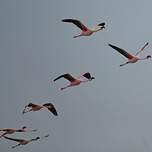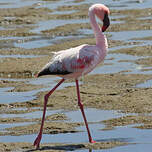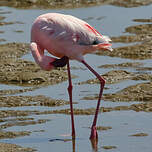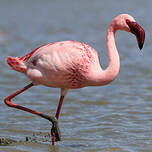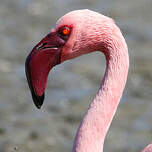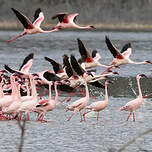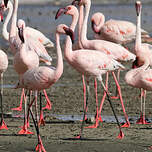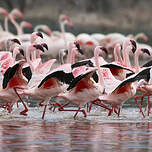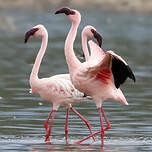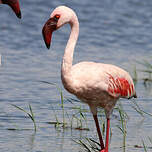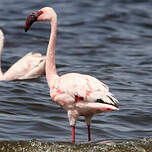Lesser Flamingo
Phoeniconaias minor - Flamant nain
Identification
Previously classified in the genus Phoenicopterus, genus of the Greater Flamingo, the Lesser Flamingo is since 2014 classified in its own genus Phoeniconaias. The species is monotypic. It is the smallest of flamingos, but it does not go unnoticed in the midst of Greater Flamingos to which it willingly mingles.
The adult Lesser Flamingo's plumage is generally pink, on average pinker than the Greater Flamingo itself. There is a significant variability in the intensity of the adults' pink plumage, in relation to the diet and breeding cycle. The most colourful part of the plumage is the top of the wing, of a vivid almost red pink, when it is not masked at rest by the scapulae and / or flank feathers. Black remiges point backwards. Without direct comparison to the Greater Flamingo, it is recognized by its dark and almost monochromatic beak from afar. Closer, one can see that it is dark carmine red with a black tip. In addition, the eye with light red iris is surrounded by a dark red circle connected to the beak. The long legs are red.
In flight, the contrast between the black remiges and the rest of the plumage is striking. The very colourful parts (medium overcovers and under axillars) appear in all their beauty.
The juvenile is very different in appearance due to the complete absence of carotenoid pigments. The contour plumage is light brown to beige. The remiges are dark brown. Even the rectrices have some brown at their tip. The wing covers, scapulae and axillaries are very brown. The beak is gray to blackish and the eye is dark. The legs are gray. At this age, the bird is therefore very brown, very dull. With time and wear, the plum age will lighten and become whitish at the end of the season, but still with brown on and under the wings.At this point, the 1st winter is still small compared to adults. Sexual maturity will not be reached until the age of 3 or 4. During all this time of immaturity, remarkably, the bird will continue to grow, the nuptial plumage appearing only in the year of the first reproduction, that is 3 or 4 years after birth.
Subspecific information monotypic species
Foreign names
- Flamant nain,
- Flamenco enano,
- flamingo-pequeno,
- Zwergflamingo,
- kis flamingó,
- Kleine Flamingo,
- Fenicottero minore,
- mindre flamingo,
- Dvergflamingo,
- plameniak menší,
- plameňák malý,
- Lille Flamingo,
- pikkuflamingo,
- Kleinflamink,
- flamenc nan,
- Dvergflæmingi,
- flaming mały,
- mazais flamingo,
- mali plamenec,
- Малый фламинго,
- コフラミンゴ,
- 小红鹳 ,
- mindre flamingo,
- 小紅鸛,
Voice song and call
Habitat
The Lesser Flamingo inhabits shallow, salty or alkaline water bodies inland as well as in less extent coastal lagoons. The eastern alkaline lakes are particularly well suitable for the species as they are wide, relatively shielded from terrestrial predators and rich in microorganisms. The mud nests can be built easily there. Outside the breeding season or at immature stage, it may frequent marginal and more restricted environments such as sewage treatment plants.
Behaviour character trait
The Lesser Flamingo is a gregarious bird at all times. Throughout the year, one can observe its colorful and perfectly coordinated marches.
Groups of a few tens to a few hundreds of individuals launch into movements of the whole, sexes and heads well raised, accompanied by beating wings in a great display of colors. These visual displays are very important for a Lesser Flamingo group, for whom sight and hearing are two major senses. The relationships between adults and later between adults and chicks depend on them.The Lesser Flamingo is nomadic; it can easily move when the environmental conditions change or food runs out. Outside of the reproductive period, the movements of Lesser Flamingos take place at night, the groups organising into V-shapes. During the day, they can carry out regular journeys around the lakes, even if abundant food does not require it.
Finally, the Lesser Flamingo is a long-lived species. Ages of 40 and even 50 have been recorded, which is a positive point for the demography of the species.
Flight
Dietfeeding habits
The Lesser Flamingo mainly has an algal diet (cyanobacteria such as spirulina and diatoms). To a lesser extent, it consumes aquatic micro-organisms, mainly rotifera.
Reproduction nesting
The breeding season varies geographically depending on the rainfall. During their coordinated migrations, couples form.
The largest colonies count several thousand couples, often close to Greater Flamingos. Within the colony, a mud nest of 30 cm high is built to prevent possible flooding and escape from too much heat. The female lays a single egg which is incubated by both parents for 28 days, in alternating 24-hour periods. At hatching, the gray downy chick eats its shell. It will then be fed by its parents with a regurgitated soup until it can feed itself. At six days, the chick joins the colony's creche. The learning of life begins. It is not easy for the very young Lesser Flamingo, drowned in the midst of thousands of other young ones, to recognize the voice of its parents who come to feed it. Hence the importance of hearing in this species. After a week, he knows how to run, at 4 weeks he has developed his juvenile plumage, at 10 weeks he feeds himself, and finally he can fly at 12 weeks. During this entire period, he is vulnerable; he is an easy prey for aerial predators such as African Pratincoles or raptors such as the Osprey. Carnivorous mammals such as jackals or hyenas can also exert a certain predation, including on adults.Geographic range
The Lesser Flamingo is mainly found in eastern Africa, on the eastern African Great Rift lakes which are very favorable to it. Smaller populations are found in West Africa (Senegal and Mauritania), southern Africa and Asia (western India and Pakistan). The overwintering area is much larger, mainly in the south of the African continent. A few scattered individuals are visible here and there, for example in the south of Spain where a couple has been observed with nuptial behavior. The species has been occasionally seen since 2008 in the Camargue and then regularly since 2013. Each time there is only one or two individuals.
Threats - protection
IUCN conservation status
concern
in the Wild
threatened
evaluated
The majority of the population, around 2 million individuals on average, is located in East Africa (Great Rift Valley). The other African populations are much smaller, with 15 to 25 000 individuals in West Africa and 55 to 65 000 in South Africa and Madagascar. Finally, they would number between 300 and 400 000 in India and Pakistan. Only three major breeding sites exist in Africa and none is subject to special protection. Their only advantage is being located in national reserves or parks, unfortunately exposed to pollution from heavy metals. Mining and hydroelectric projects have never been completely abandoned. This could lead to a rapid decrease in the population of the species classified as near-threatened and very sensitive to pollution and human disturbances. An international action plan was created in 2006 to regularly monitor the populations, attempt to protect them in order to reverse a declining trend. Unfortunately, the threats remain numerous.
Sources of information
- IOC World Bird List (v15.1), Gill, F and D Donsker (Eds). 2025-12-07.
- ARKive, Christopher Parsons
- BirdLife International, BirdLife International
- HBW Alive,
- xeno-canto, Sharing bird sounds from around the world,
Other sources of interest
 Specification sheet created on
25/07/2023 by Nathalie Santa Maria
Specification sheet created on
25/07/2023 by Nathalie Santa MariaTranslation by AI Oiseaux.net
© 1996-2025 Oiseaux.net
- Accipitriformes
- Aegotheliformes
- Anseriformes
- Apodiformes
- Apterygiformes
- Bucerotiformes
- Caprimulgiformes
- Cariamiformes
- Casuariiformes
- Charadriiformes
- Ciconiiformes
- Coliiformes
- Columbiformes
- Coraciiformes
- Cuculiformes
- Eurypygiformes
- Falconiformes
- Galliformes
- Gaviiformes
- Gruiformes
- Leptosomiformes
- Mesitornithiformes
- Musophagiformes
- Nyctibiiformes
- Opisthocomiformes
- Otidiformes
- Passeriformes
- Pelecaniformes
- Phaethontiformes
- Phoenicopteriformes
- Piciformes
- Podargiformes
- Podicipediformes
- Procellariiformes
- Psittaciformes
- Pterocliformes
- Rheiformes
- Sphenisciformes
- Steatornithiformes
- Strigiformes
- Struthioniformes
- Suliformes
- Tinamiformes
- Trogoniformes

